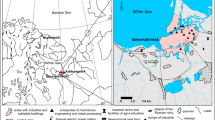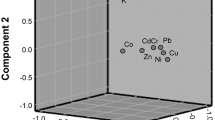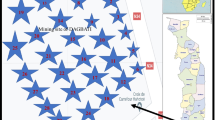Abstract
In view of the relevance of urban parks and public squares to the well-being of the population, coupled with the presence of uraniferous phosphorite in the Metropolitan Region of Recife, State of Pernambuco, Brazil, this study aimed to evaluate the contribution of natural radionuclides and the toxic chemical elements As, Cd, Ni, Pb, and Sb found in the soils of urban green spaces to the population’s carcinogenic risks. Samples consisting of soils collected from a depth of 0–15 cm were analyzed by High Resolution Gamma Spectrometry, Graphite Furnace Atomic Absorption Spectrometry and Inductively Coupled Plasma Mass Spectrometry, after chemical treatment. The annual effective dose rates were estimated to be lower than the threshold for individual exposure to ionizing radiation of 1 mSv year−1, even in green spaces close to uraniferous outcrops. There were As, Cd, Ni, and Pb hotspots in these soils, resulting in high values of Pollution Load Index (PLI) for practically all the studied green spaces. Although considerable non-carcinogenic risks were not found, two green spaces presented significant carcinogenic risks for adults. Furthermore, significant carcinogenic risks would be expected for children at all study sites.




Similar content being viewed by others
Data availability
The authors declare that all the data generated and used during this study is included in the published text.
References
Ferreira MS, Fontes MPF, Pacheco AA, Ker JC, Lima HN (2021) Health risks of potentially toxic trace elements in urban soils of Manaus city, Amazon, Brazil. Environ Geochem Health 43:3407–3427. https://doi.org/10.1007/s10653-021-00834-0
Garí M, Grzesiak M, Krekora M, Kaczmarek P, Jankowska A, Król A, Polańska K (2021) Prenatal exposure to neurotoxic metals and micronutrients and neurodevelopmental outcomes in early school age children from Poland. Environ Res 204:112049. https://doi.org/10.1016/j.envres.2021.112049
Minkina T, Konstantinova E, Bauer T, Mandzhieva S, Sushkova S, Chaplygin V, Maksimov A (2020) Environmental and human health risk assessment of potentially toxic elements in soils around the largest coal-fired power station in Southern Russia. Environ Geochem Health 43:2285–2300. https://doi.org/10.1007/s10653-020-00666-4
Renzetti S, Cagna G, Calza S, Conversano M, Fedrighi C, Forte G, Giorgino A, Guazzetti S, Majorani C, Oppini M, Peli M, Petrucci F, Pino A, Placidi D, Senofonte O, Zoni S, Alimonti A, Lucchini RG (2021) The effects of the exposure to neurotoxic elements on Italian schoolchildren behavior. Sci Rep 11:9898. https://doi.org/10.1038/s41598-021-88969-z
Lee ACK, Maheswaran R (2010) The health benefits of urban green spaces: a review of the evidence. J Public Health 33:212–222. https://doi.org/10.1093/pubmed/fdq068
Sun Y, Xia L, Benmarhnia T, Jiu-Chiuan C, Avila C, Sacks DA, Chiu V, Slezak J, Molitor J, Getahun D, Jun W (2022) Exposure to air pollutant mixture and gestational diabetes mellitus in Southern California: results from electronic health record data of a large pregnancy cohort. Environ Int 158:106888. https://doi.org/10.1016/j.envint.2021.106888
Wang M, Han Q, Gui C, Cao J, Liu Y, He X, He Y (2019) Differences in the risk assessment of soil heavy metals between newly built and original parks in Jiaozuo, Henan Province, China. Sci Total Environ 676:1–10. https://doi.org/10.1016/j.scitotenv.2019.03.396
Amaral RS, Morais ENL, Santos Júnior JA, Silva ANC, Bezerra JD, Santos Junior OP (2018) Environmental ionizing radiation dose outdoor in an inhabited area with a high concentration of urano-phosphate in northeast of Brazil. Radiat Prot Dosimetry 181:181–189. https://doi.org/10.1093/rpd/ncy005
UNSCEAR - United Nations Scientific Committee on the Effects of Atomic Radiation (2010) Report of the United Nations Scientific Committee on the Effects of Atomic Radiation. United Nations, New York. https://www.unscear.org/unscear/uploads/documents/unscear-reports/UNSCEAR_2008_Report_Vol.I-CORR.pdf
Charlesworth S, De Miguel E, Ordóñez A (2011) A review of the distribution of particulate trace elements in urban terrestrial environments and its application to considerations of risk. Environ Geochem Health 33:103–121. https://doi.org/10.1007/s10653-010-9325-7
IBGE - Instituto Brasileiro de Geografia e Estatística (2017) Indicadores sociais da Região Metropolitana do Recife e Paulista. https://cidades.ibge.gov.br/brasil/pe/recife/panorama (in Portuguese)
Silva VR, Oliveira CA (2016) Atividade turística na cidade do Recife: Levantamento e diagnóstico de sítios arqueológicos. Rev Arqueol Públ 9:3–18. DOI: https://doi.org/10.20396/rap.v9i2.8642864
Paiva JDS, Sousa EE, Farias EEG, Carmo AM, Souza EM, França EJ (2016) Natural radionuclides in mangrove soils from the State of Pernambuco, Brazil. J Radioanal Nucl Chem 307:883–889. https://doi.org/10.1007/s10967-015-4446-1
European Commission (1999) Radiation protection: 112 radiological protection principles concerning the natural radioactivity of building materials. European Commission, Brussels. https://ec.europa.eu/energy/sites/default/files/documents/112.pdf
Rothery E (ed.) (1988) Analytical methods for graphite tube atomizers. Varian, Melbourne
Ellison SLR, Williams A (2012) Guide Eurachem: quantifying uncertainty in analytical measurement, 3rd ed. Eurachem, Teddington
ISO - International Organization for Standardization (2005) ISO 13528 - Statistical methods for use in proficiency testing by interlaboratory comparisons. ISO, Genebra
CPRH - Agência Estadual do Meio Ambiente (2014) Instrução Normativa CPRH nº 007/2014 (in Portuguese)
Harb MK, Ebqaai M, Al-rashidi A, Alaziqi BH, Al Rashdi MS, Ibrahim B (2015) Investigation of selected heavy metals in street and house dust from Al-Qunfudah, Kingdom of Saudi Arabia. Environ Earth Sci 74:1755–1763. https://doi.org/10.1007/s12665-015-4184-2
Memoli V, Esposito F, Panico SC, De Marco A, Barile R, Maisto G (2019) Evaluation of tourism impact on soil metal accumulation through single and integrated indices. Sci Total Environ 682:685–691. https://doi.org/10.1016/j.scitotenv.2019.05.211
Tomlinson DL, Wilson JG, Harris CR, Jeffrey DW (1980) Problems in the assessment of heavy-metal levels in estuaries and the formation of a pollution index. Helgol Meeresunters 33:566–575
De Miguel E, Iribarren I, Chacón E, Ordoñez A, Charlesworth S (2007) Risk-based evaluation of the exposure of children to trace elements in playgrounds in Madrid (Spain). Chemosphere 66:505–513. https://doi.org/10.1016/j.chemosphere.2006.05.065
Luo XS, Ding J, Xu B, Wang YJ, Li HB, Yu S (2012) Incorporating bioaccessibility into human health risk assessments of heavy metals in urban park soils. Sci Total Environ 424:88–96. https://doi.org/10.1016/j.scitotenv.2012.02.053
USEPA - United States Environmental Protection Agency (2007) Guidance for Evaluating the Oral Bioavailability of Metals in Soils for Use in Human Health Risk Assessment. U.S. Environmental Protection Agency, Washington
USEPA - United States Environmental Protection Agency (2011) Exposure Factors Handbook 2011 Edition. U.S. Environmental Protection Agency, Washington
Wang X, Sun Y, Li S, Wang H (2019) Spatial distribution and ecological risk assessment of heavy metals in soil from the Raoyanghe Wetland, China. PLoS One 14:e0220409. https://doi.org/10.1371/journal.pone.0220409
Wang N, Wang A, Kong L, He M (2018) Calculation and application of Sb toxicity coefficient for potential ecological risk assessment. Sci Total Environ 610–611:167–174. https://doi.org/10.1016/j.scitotenv.2017.07.268
USEPA - United States Environmental Protection Agency (1991) Risk Assessment Guidance for Superfund Volume I: Human Health Evaluation Manual Supplemental Guidance: “Standard Default Exposure Factors” Interim Final. U. S. Environmental Protection Agency, Washington
USEPA - United States Environmental Protection Agency (2008) Standard operating procedure for an in vitro bioaccessibility assay for lead in soil. U. S. Environmental Protection Agency, Washington
UNSCEAR - United Nations Scientific Committee on the Effects of Atomic Radiation (2008) Report of the United Nations Scientific Committee on the Effects of Atomic Radiation: Fifty-sixth Session (10–18 July 2008). United Nations, New York
Fernández S, Cotos-Yáñez T, Roca-Pardiñas J, Ordóñez C (2018) Geographically Weighted Principal Components Analysis to assess diffuse pollution sources of soil heavy metal: Application to rough mountain areas in Northwest Spain. Geoderma 311:120–129. https://doi.org/10.1016/j.geoderma.2016.10.012
França EJ, De Nadai Fernandes EA, Bacchi MA, Elias C (2007) Atlantic Forest: A natural reservoir of chemical elements. J Radioanal Nucl Chem 276:221–228. https://doi.org/10.1007/s10967-007-0437-1
Kabata-Pendias A, Mukherjee AB (2007) Trace elements from soil to human. Springer, Berlin
Kabata-Pendias A (2011) Trace elements in soils and plants. CRC Press, Boca Raton
Cao P, Fujimori T, Juhasz A, Takaoka M, Oshita K (2019) Bioaccessibility and human health risk assessment of metal(loid)s in soil from an e-waste open burning site in Agbogbloshie, Accra, Ghana. Chemosphere 240:124909. https://doi.org/10.1016/j.chemosphere.2019.124909
De Angelis C, Galdiero M, Pivonello C, Salzano C, Gianfrilli D, Piscitelli P, Pivonello R (2017) The environment and male reproduction: the effect of cadmium exposure on reproductive function and its implication in fertility. Reprod Toxicol 73:105–127. https://doi.org/10.1016/j.reprotox.2017.07.021
Kabata-Pendias A, Szteke B (2015) Trace elements in abiotic and biotic environments. CRC Press, Boca Raton
Acknowledgements
The authors would like to thank CNPq, Fundação CAPES, FACEPE, and CNEN for their financial support, which made it possible to develop this study, as well as the Municipal Maintenance and Urban Cleaning of Recife (EMLURB) for authorizing access to the green spaces in the Metropolitan Region of Recife.
Author information
Authors and Affiliations
Contributions
Elvis J. França: data processing, writing and reviewing; Marcelo B. G. de Lira, Fabiano S. Ferreira, Ítalo B. Silva, Mechele S. Santos, Matheus A. R. Costa: sampling, sample preparation, chemical treatment and analysis; Crescêncio A. Silva Filho, Alesxandro F. Nascimento, Thiago O. Santos: chemical analysis.
Corresponding author
Ethics declarations
Conflict of interest
The authors declare no conflict of interest.
Ethical approval
This work does not involve experimentation on human or other vertebrate animals.
Consent to participate
All authors consent to participate into this research.
Consent to Publish
All authors consent to publish the paper contents.
Additional information
Publisher's Note
Springer Nature remains neutral with regard to jurisdictional claims in published maps and institutional affiliations.
Rights and permissions
Springer Nature or its licensor (e.g. a society or other partner) holds exclusive rights to this article under a publishing agreement with the author(s) or other rightsholder(s); author self-archiving of the accepted manuscript version of this article is solely governed by the terms of such publishing agreement and applicable law.
About this article
Cite this article
De França, E.J., de Lira, M.B.G., Ferreira, F.S. et al. Natural radioisotopes and chemical elements causing carcinogenic risks in soils of urban green spaces in the Metropolitan Region of Recife, Pernambuco, Brazil?. J Radioanal Nucl Chem 332, 3943–3955 (2023). https://doi.org/10.1007/s10967-023-09098-7
Received:
Accepted:
Published:
Issue Date:
DOI: https://doi.org/10.1007/s10967-023-09098-7




